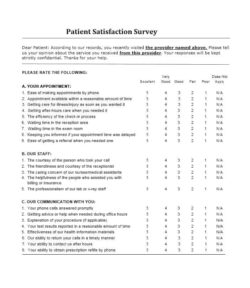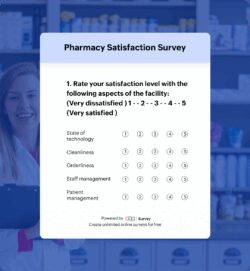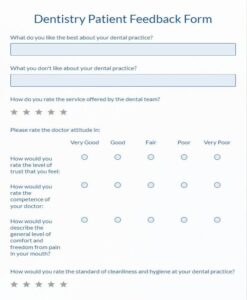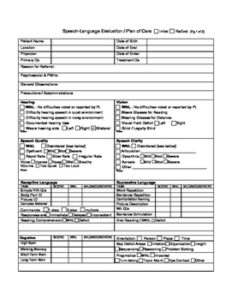In the delicate world of home health care, understanding how patients feel about the services they receive isn’t just a good idea, it’s absolutely essential. After all, care delivered in the comfort of one’s own home is deeply personal and relies heavily on trust, comfort, and effective communication. Knowing what’s working well and what might need a little tweaking can make all the difference in a patient’s healing journey and overall quality of life.
That’s where a well-designed satisfaction survey comes into play. It provides a structured way to gather honest feedback, allowing agencies to not only maintain high standards but also continuously improve. Think of it as a direct line to your patients’ experiences, offering invaluable insights that can transform good care into truly exceptional care. Having a ready-to-use template can save time and ensure you’re asking all the right questions from the get-go.
Why Patient Feedback is Crucial in Home Health Care
Providing care within a patient’s home environment presents unique challenges and opportunities compared to a clinical setting. It’s an intimate service where caregivers become temporary parts of a household, requiring an even higher level of empathy, respect, and professionalism. In this context, feedback from patients and their families isn’t just about service quality; it’s about comfort, dignity, and a sense of security. It helps to affirm that the care provided aligns with the patient’s individual needs and preferences, fostering a stronger patient-provider relationship built on trust.
Moreover, patient feedback acts as an early warning system. It can highlight minor issues before they escalate into major problems, whether it’s a scheduling conflict, a communication misunderstanding, or a specific concern about a care provider. Addressing these points promptly demonstrates a commitment to excellence and responsiveness, which can significantly enhance patient retention and overall satisfaction. Ignoring feedback, on the other hand, can lead to dissatisfaction, patient churn, and damage to an agency’s reputation within the community.
Gathering structured feedback also provides tangible data that can be used for staff training, policy adjustments, and strategic planning. It moves beyond anecdotal evidence to give a clearer picture of service strengths and areas requiring improvement across the board. This data-driven approach ensures that improvements are targeted and effective, leading to more efficient operations and better patient outcomes. Ultimately, it allows home health care providers to adapt and evolve, staying responsive to the ever-changing needs of their diverse patient base.
Without a systematic way to collect these insights, agencies are essentially operating in the dark, making assumptions about patient satisfaction rather than basing decisions on concrete information. This is why a comprehensive feedback mechanism is not just beneficial, but truly indispensable for any home health care provider aiming for long-term success and positive patient experiences.
Key Areas to Cover in Your Survey
Designing Your Effective Home Health Care Satisfaction Survey Template
Creating a survey that genuinely captures valuable insights requires careful thought about both the questions asked and how they are presented. The goal is to make it easy and comfortable for patients or their family members to share their true feelings without feeling overwhelmed or confused. Start by considering the primary objectives of your survey: are you looking for overall satisfaction, specific feedback on a new service, or insights into a particular caregiver’s performance? Clearly defining these goals will help you select the most relevant questions.
Think about using a mix of question types to gather comprehensive data. Rating scales, like a Likert scale (e.g., “Strongly Disagree” to “Strongly Agree” or “Poor” to “Excellent”), are great for quantifiable data and allow for easy comparison over time. Open-ended questions, on the other hand, provide rich qualitative data, giving patients the space to elaborate on their experiences, feelings, and suggestions in their own words. These qualitative insights often uncover issues or ideas that multiple-choice questions might miss, offering deeper understanding.
The method of survey distribution is also crucial. For some patients, a simple paper survey left with them might be best, while others might prefer an email link to an online survey platform that can be completed at their convenience. Phone interviews can also be effective for those who might struggle with written formats, allowing for real-time clarification and deeper conversation. Offering multiple options increases participation rates and ensures you reach a broader spectrum of your patient population.
Once you’ve collected the responses, the work doesn’t stop there. The true value of a home health care satisfaction survey template comes from the analysis of the data and the subsequent actions taken based on those findings. Regularly review the feedback, identify recurring themes or issues, and share these insights with your team. Use the data to celebrate successes, implement targeted training, adjust policies, and continuously refine your services. This iterative process of feedback, analysis, and action is what truly elevates the quality of care provided.
Listening attentively to the voices of those you serve is perhaps the most powerful tool for improvement in the home health care sector. By consistently seeking and acting upon patient feedback, agencies can foster an environment of continuous improvement and responsiveness. This dedication to understanding and meeting patient needs not only elevates the standard of care but also builds a reputation for excellence and empathy.
Ultimately, valuing patient input through a structured survey mechanism transforms feedback from a mere formality into a vital component of your agency’s success. It ensures that every decision made is informed by the real-world experiences of those who matter most, leading to higher patient satisfaction, stronger community trust, and a truly patient-centered approach to home health care.



